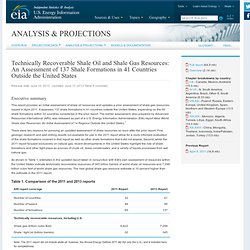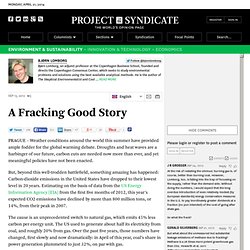

Fullreport.pdf. Analysis & Projections. Release date: June 10, 2013 Updated: June 13, 2013 Table 5 corrected Executive summary This report provides an initial assessment of shale oil resources and updates a prior assessment of shale gas resources issued in April 2011.

It assesses 137 shale formations in 41 countries outside the United States, expanding on the 69 shale formations within 32 countries considered in the prior report. The earlier assessment, also prepared by Advanced Resources International (ARI), was released as part of a U.S. Energy Information Administration (EIA) report titled World Shale Gas Resources: An Initial Assessment of 14 Regions Outside the United States.1 There were two reasons for pursuing an updated assessment of shale resources so soon after the prior report. The report covers the most prospective shale formations in a group of 41 countries that demonstrate some level of relatively near-term promise and that have a sufficient amount of geologic data for a resource assessment. Future efforts. The last sip.
A fever has swept over American energy observers in recent weeks as they compete to write the most optimistic story of impending energy independence.

For example, see Clifford Krauss in the New York Times, Citigroup's Ed Morse in the Wall Street Journal, and Raymond James's outlook covered by Angel Gonzalez for Dow Jones, with perhaps the "Bonanza" theme song in the background. Or if not a fever, then perhaps a mental illness, or heavy doses of good acid. Because as far as the data shows, none of these projections have any basis in reality. The vogue suggestion is that North American oil production is about to surge and wipe out our 8.7 million barrels per day (mbpd) of oil imports, making us self-sufficient in oil by 2020.
Citigroup, under the leadership of Morse, probably holds the current record for the most outlandish projection. What the Frack? Do we really have 100 years' worth of shale gas? - GetRealList. I have a new piece published in Slate today, examining the oft-repeated claim that we have 100 years’ worth of shale gas resources.

In terms of proved reserves, we only have 11 years’ worth. So what’s the deal? Read it here: What the Frack? A Fracking Good Story by Bjørn Lomborg. Exit from comment view mode.

Click to hide this space PRAGUE – Weather conditions around the world this summer have provided ample fodder for the global warming debate. Droughts and heat waves are a harbinger of our future, carbon cuts are needed now more than ever, and yet meaningful policies have not been enacted. But, beyond this well-trodden battlefield, something amazing has happened: Carbon-dioxide emissions in the United States have dropped to their lowest level in 20 years. Estimating on the basis of data from the US Energy Information Agency (EIA) from the first five months of 2012, this year’s expected CO2 emissions have declined by more than 800 million tons, or 14%, from their peak in 2007. The cause is an unprecedented switch to natural gas, which emits 45% less carbon per energy unit.
Cracking the Code: Is the Monterey Shale the Next Big Boom or Bust? California’s Monterey Shale could turn out to be one of the largest oil producing shales in the world.

In fact, some experts believe it could hold more oil than the entire Bakken Shale. The Monterey Shale covers large concentrations of acreage in the San Joaquin, Los Angeles and Monterey Basins. Arthur Berman, Shale Is Magical Thinking. Identification des roches. Gaz de schiste : un engouement mondial, mais beaucoup de doutes. Le Monde.fr | • Mis à jour le | Par Audrey Garric.

Pétrole, gaz : la révolution énergétique américaine. «La carte mondiale du pétrole est en train de complètement changer.»

Ce constat d’Antoine Halff, responsable du suivi du marché pétrolier au sein de l’Agence internationale de l’énergie (AIE) est largement partagé par les experts. L’événement le plus significatif sur la planète pétrole, au cours de l’année écoulée, a été la montée en puissance de la production de brut aux États-Unis. Après le gaz, le pétrole. «L’essor spectaculaire de pétroles de schiste, en dépit de toutes les contraintes logistiques qui semblaient devoir l’entraver, a surpris par sa rapidité», concède-t-il. Et cette ruée vers les pétroles non conventionnels qui se concentre autour de la formation géologique Bakken, dans le Dakota du Nord, est appelée à se poursuivre. Can the Bakken Oil Formation Reach 1 Million Barrels a Day? US Energy Independence: The Next Big Thing for 2013? Energy investment is about more than just the commodities; it's about growth.

That's why, for example, the emerging economies theme has been an important one for investors who know that every business and modern home in Brazil, Russia, China or on the African continent will need to keep the lights on somehow. But the next big thing for 2013 may be in our own backyards: the drive toward U.S. energy independence. Shale oil and tight oil. Since 2005, the “total oil supply” for the United States as reported by the Energy Information Administration increased by 2.2 million barrels per day.

Of this, 1.3 mb/d, or 60%, has come from natural gas liquids and biofuels, which really shouldn’t be added to conventional crude production for purposes of calculating the available supply. Of the 800,000 b/d increase in actual field production of crude oil, almost all of the gain has come from shale and other tight formations that horizontal fracturing methods have only recently opened up. Here I offer some thoughts on how these new production methods change the overall outlook for U.S. oil production. Ponzi on Shale oil. Gaz de schiste : "Truthland" démonte les mensonges de "Gasland" Le film Gasland de Josh Fox n’était qu’un mauvais film d’épouvante, plein de biais de présentation et de déformations volontaires de la réalité.

La vidéo Truthland présentée par Vincent Bénard. Vous trouverez ci-dessous, traduit en français, le documentaire « Truthland« , réponse argumentée d’une enseignante de Pennsylvanie aux allégations du film anti-gaz de schistes « Gasland« . Réalisé simplement sans grands moyens, ce petit film vaut largement 32 minutes de votre temps pour vous faire une autre opinion sur les gaz de schiste.